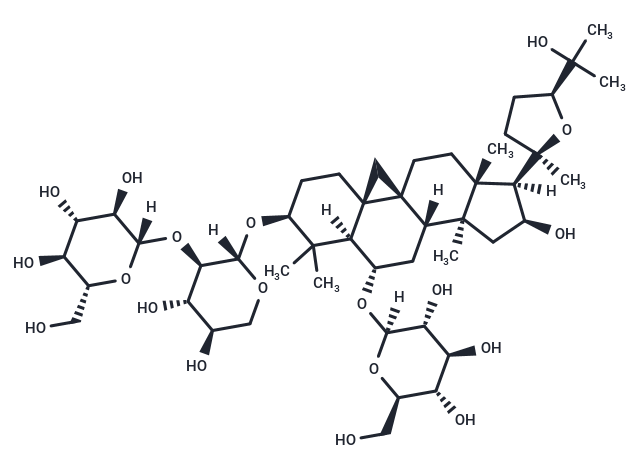Shopping Cart
- Remove All
 Your shopping cart is currently empty
Your shopping cart is currently empty

Astragaloside VI could improve wound healing by activating the EGFR/ERK signaling pathway.

| Pack Size | Price | Availability | Quantity |
|---|---|---|---|
| 10 mg | $598 | Backorder |
| Description | Astragaloside VI could improve wound healing by activating the EGFR/ERK signaling pathway. |
| In vitro | Pretreatment with Astragaloside VI (1 μM) enhances EGFR activation in HaCaT cells and significantly promotes cell proliferation in both HaCaT and HDF cells. As a principal intestinal metabolite of astragalosides, Astragaloside VI is the most potent in stimulating EGFR activation. Furthermore, it is comparable to the positive control, EGF, which is known to increase cell proliferation by 1.5 times in HaCaT cells. Additionally, Astragaloside VI facilitates neural stem cell proliferation and improves neurological function recovery following transient cerebral ischemic injury through the activation of EGFR/MAPK signaling pathways [1] [2]. |
| In vivo | In the simple non-infected wound model, wound healing in mice is accelerated by Astragaloside VI, wherein the time required for wound closure is shortened by approximately 2-4 days, compared to that in the control group. Topical treatment with Astragaloside VI reduces the volume of pus produced, compared to the control group. Astragaloside VI treated wounds show an accelerated rate of healing, compared to the control and vaseline groups. By day 22, the Astragaloside VI -treated wounds fully close, whereas the blank and vaseline-treated wounds do not fully close until day 26. Astragaloside VI increases blood vessel formation in both the non-infected and infected wound models [1]. Astragaloside VI could effectively activate EGFR/MAPK signaling cascades, promote NSCs proliferation and neurogenesis in transient cerebral ischemic brains, and improve the repair of neurological functions in post-ischemic stroke rats [2]. |
| Molecular Weight | 947.122 |
| Formula | C47H78O19 |
| Cas No. | 84687-45-6 |
| Relative Density. | 1.46 g/cm3 (Predicted) |
| Storage | Powder: -20°C for 3 years | In solvent: -80°C for 1 year | Shipping with blue ice. |

Copyright © 2015-2025 TargetMol Chemicals Inc. All Rights Reserved.